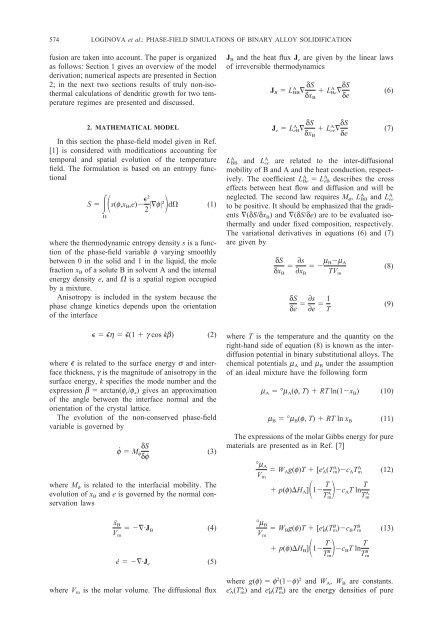Phase-field modeling of diffusion controlled phase ... - KTH Mechanics
Phase-field modeling of diffusion controlled phase ... - KTH Mechanics
Phase-field modeling of diffusion controlled phase ... - KTH Mechanics
You also want an ePaper? Increase the reach of your titles
YUMPU automatically turns print PDFs into web optimized ePapers that Google loves.
574 LOGINOVA et al.: PHASE-FIELD SIMULATIONS OF BINARY ALLOY SOLIDIFICATIONfusion are taken into account. The paper is organizedas follows: Section 1 gives an overview <strong>of</strong> the modelderivation; numerical aspects are presented in Section2; in the next two sections results <strong>of</strong> truly non-isothermalcalculations <strong>of</strong> dendritic growth for two temperatureregimes are presented and discussed.J B and the heat flux J e are given by the linear laws<strong>of</strong> irreversible thermodynamicsJ B L A BB δS Lδx A Be δSB δe(6)2. MATHEMATICAL MODELIn this section the <strong>phase</strong>-<strong>field</strong> model given in Ref.[1] is considered with modifications accounting fortemporal and spatial evolution <strong>of</strong> the temperature<strong>field</strong>. The formulation is based on an entropy functionalS s(f,x B ,e) 22 |f|2d (1)where the thermodynamic entropy density s is a function<strong>of</strong> the <strong>phase</strong>-<strong>field</strong> variable f varying smoothlybetween 0 in the solid and 1 in the liquid, the molefraction x B <strong>of</strong> a solute B in solvent A and the internalenergy density e, and is a spatial region occupiedby a mixture.Anisotropy is included in the system because the<strong>phase</strong> change kinetics depends upon the orientation<strong>of</strong> the interface¯h ¯(1 g cos kb) (2)where ¯ is related to the surface energy s and interfacethickness, g is the magnitude <strong>of</strong> anisotropy in thesurface energy, k specifies the mode number and theexpression b arctan(f y /f x ) gives an approximation<strong>of</strong> the angle between the interface normal and theorientation <strong>of</strong> the crystal lattice.The evolution <strong>of</strong> the non-conserved <strong>phase</strong>-<strong>field</strong>variable is governed byḟ M fδSδf(3)where M f is related to the interfacial mobility. Theevolution <strong>of</strong> x B and e is governed by the normal conservationlawsJ e L A eB δS Lδx A ee δSB δe(7)L A BB and L A ee are related to the inter-<strong>diffusion</strong>almobility <strong>of</strong> B and A and the heat conduction, respectively.The coefficient L A Be L A eB describes the crosseffects between heat flow and <strong>diffusion</strong> and will beneglected. The second law requires M f , L A BB and L A eeto be positive. It should be emphasized that the gradients(δS/δx B ) and (δS/δe) are to be evaluated isothermallyand under fixed composition, respectively.The variational derivatives in equations (6) and (7)are given byδSδx B ∂s∂x B m Bm ATV m(8)δSδe ∂s∂e 1 T(9)where T is the temperature and the quantity on theright-hand side <strong>of</strong> equation (8) is known as the inter<strong>diffusion</strong>potential in binary substitutional alloys. Thechemical potentials m A and m B under the assumption<strong>of</strong> an ideal mixture have the following formm A °m A (f, T) RT ln(1x B ) (10)m B °m B (f, T) RT ln x B (11)The expressions <strong>of</strong> the molar Gibbs energy for purematerials are presented as in Ref. [7]°m AV m W A g(f)T [e s A(T A m)c A T A m (12) p(f)H A ]1 T T A mc A T ln T T A mẋ BV m·J B (4)°m BV m W B g(f)T [e s B(T B m)c B T B m (13) p(f)H B ]1 T T B mc B T ln T T B mė ·J e (5)where V m is the molar volume. The <strong>diffusion</strong>al fluxwhere g(f) f 2 (1f) 2 and W A , W B are constants.e s A(T A m) and e s B(T B m) are the energy densities <strong>of</strong> pure
















